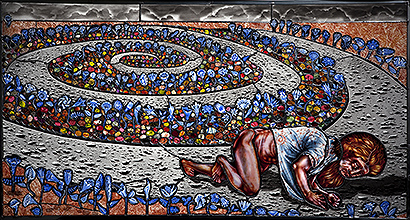Judith Schaechter
 tained glass reached its peak in the 12th Century and it's been downhill since then. Perhaps stained glass is an odd medium to choose if one wishes to participate in the world of contemporary fine art and indeed, it is! Yet, I found it altogether irresistible. tained glass reached its peak in the 12th Century and it's been downhill since then. Perhaps stained glass is an odd medium to choose if one wishes to participate in the world of contemporary fine art and indeed, it is! Yet, I found it altogether irresistible.
Although I went to art school to study painting, I knew almost instantly when I tried stained glass that it was what I wanted to pursue for the rest of my life. Why? Unlike most raw materials, glass is extremely attractive before the artist ever touches it. I found I like to really manipulate it, stretch it and transform it and distort it in unnatural ways. I like to see what possibilities lie in mating difficult emotional ideas with sensuous but cruel materials. I like a lot of resistance. I like cold, hard, sharp, vicious stuff to fight with--I dislike compliance! Perhaps I want to punish it for being so pretty when I sometimes feel so ugly.
I also felt "in sync" with glass. When I was a painter I painted fast and furiously and ultimately threw everything out. This didn't happen with glass because it was so labor intensive. The tedium factor and the variety of processes allowed me to focus and concentrate. By the time I managed to do something to the glass, I had developed feelings of attachment and was hardly going to throw it away.
Without launching into the full technical explanation, I would describe my process as derived almost entirely from traditional techniques in use for centuries. The imagery is predominantly engraved into layers of glass; only the black and yellow are painted and fired on in a kiln. The pieces are soldered together in a copperfoil and lead matrix.
Much of my work is improvised and made without prior plans or sketches. Nothing is more inhibiting that the pressure to come up with some Brilliant Artistic Idea--I do a lot of doodling in front of the TV or at meetings and this distraction frees me to mess up. All my best work seems to result from accidents and mistakes.
I don't have clear narratives in mind and am trying to be deliberately vague but with hindsight I can say a few things about the subject of my work. Of course, as I have said, the glass is part of that. I found the beauty of glass to be the perfect counterpoint to ugly and difficult subjects. A radiant, transparent, glowing figure is not the same as a picture of a figure (which reflects light). It's a blatant reference to holiness or some type of "super natural" state of being. In terms of my figures, although they are supposed to be ordinary people doing ordinary things, I see them as having much in common with the old medieval windows of saints and martyrs.
They seem to be caught in a transitional moment when despair becomes hope or darkness becomes inspiration. They seem poised between the threshold of everyday reality and epiphany, caught between tragedy and comedy.
It seems my work is centered on the idea of transforming the wretched into the beautiful in theme as well as design. For me, this means taking what is typically negative--say, unspeakable grief, unbearable sentimentality or nerve wracking ambivalence, and representing it in such a way that it is inviting and safe to contemplate and captivating to look at. I am at one with those who believe art is a way of feeling ones feelings in a deeper, more poignant way.
Medieval windows sought to confer inspiration and enlightenment to those who would see it. Beholding a stained glass window can enable, encourage and literally enact the process of being filled with light. It sounds like some kind of preternatural phenomenon, but it's a physical fact. While one is busy identifying and empathizing with the image, one also experiences physically the warming, filling sensations of light. It's so persuasive not because the pictures are convincing narratives but because the colors are overwhelming and the light is sublime...and, by golly, it's coming from inside you, it's part of you.
2008

"Widow"
26" x 52"
2009

"The Cold Genius"
25"x 35" (bottom) x 43" (top)

"The Sin Eater"
25" x 46"
2011

"The Battle of Carnival and Lent"
56" x 56"

"Mary Magdelane"
15" x 57"

"Sister"
31" x 42"
2012

"Feral Child"
5" x 42"

"Our Ladies"
22" x 25"
2013

"A Play About Snakes"
27" x 52"

"The Birth of Eve"
57" x 31"
| 